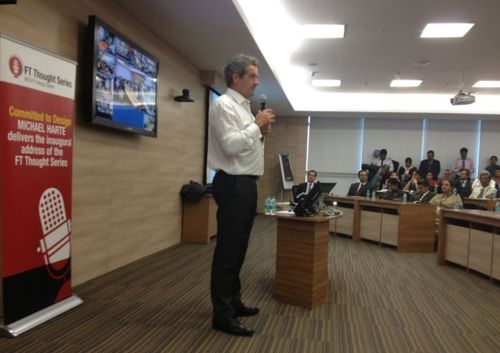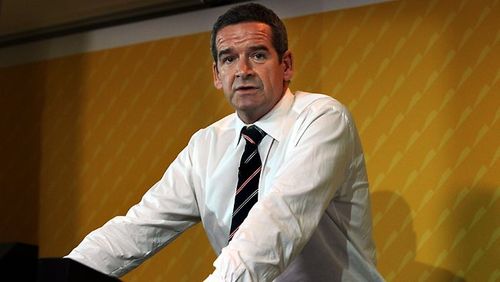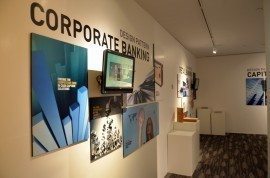
Time to head home after a day in India at the
launch of the new design centre for finance launched by Polaris Financial
Technology in Chennai (Madras for the old folks out there).

As you walk into the Design Centre, you are greeted by a map of the world ... completely made out of Indian Rupees!
A fascinating trip, not least because Polaris
has injected something into software development that I have not seen before:
creativity.
This was clearly demonstrated by Michael Harte, CIO of Commonwealth Bank of Australia (CBA).
Over the past five years, he has replaced the bank's core systems, moved much of the banks services to the cloud, created many apps and innovations that have given CBA global recognition and more.
Anyway, I was in India for the launch of Polaris's Design Centre.
The design centre is a collaborative space for
their clients to work with them in seven different development cells under the acronym: COPARIS.
COPARIS stands for Customer, Operations, Performance, Analytics, Risk, Integration and
Security, and represent the seven core competencies required for any bank system.
These seven areas operate in the Design Centre as small teams
of creativity to solve customer challenges and issues.
I’m not going to say much more about the Design
Centre as you can read more about that at the end of this blog entry, as cut
and pasted from my friend David Bannister’s summary (David
was also over here for the launch).
I’d rather focus upon the presentation from the
four million dollar man.
That’s how much
Michael Harte, Chief Information Officer (CIO) at Commonwealth Bank of Australia
(CBA) earns, and Michael gave the keynote at
the opening of the Design Centre.

For those oldies out there, you may remember
the six-million dollar man, Steve Austin. In those days, a million dollars was a lot of
money. Today, we would think about a
programme called the six-BILLION dollar man, as a mere million is not so much,
is it?
Anyways, four million dollars is the annual
remuneration of Commonwealth Bank’s CIO, near double what some
Bank CEO’s get paid (RBS CEO Stephen Hester’s remuneration was half this in 2012).
Why would you pay a CIO so much?
Because he’s worth it, as L’Oreal would say or,
in this case, as the Australian CIO Magazine says:
In October 2008 the bank went through a substantial
reorganisation that saw a new division created — Enterprise Services — which
Harte was appointed to lead, while maintaining his existing CIO title. Quoting
from Harte's CBA biography:
"The Group formed Enterprise Services in October 2008
to enable an end-to-end service and process focus as well as accelerate the
delivery of innovative customer solutions."
What this really means,
when it boils down to it, is that Harte is no longer really just a chief
information officer or technology executive — or, looking at it the other way
around — that the CIO role in large Australian organisations is increasingly
changing away from just being focused on IT.
In fact, he’s a bit of a hero to some, such as The Australian newspaper,
who regularly place Michael at the top of the rankings for Technology
leaders in Australia:
There's an
adage that the best IT system upgrades are the ones that users don't notice. If
that's the case, Michael Harte must be a very happy man.
As Commonwealth Bank chief
information officer, Harte has been responsible for driving a program of change
that's touched every facet of the giant organisation's operations. Core systems
have been replaced and delivery channels enhanced to improve customer
service.
Such things are not for the faint hearted. Changing the technology that
underpins the bank's fundamental activities could have caused massive
disruption, cost blowouts and customer frustration. Yet the four-year project
has been completed without any major hitches.
Now that’s not quite true as CBA has had several outages in
the last couple of years:
But these are minor in the overall scheme of things when, as
I blogged recently, banking technology is ‘biological suicide’ and will often be the
downfall of any business.
Therefore, in the scheme of things, a five year core systems
replacement project that has succeeded in placing CBA at the forefront of not
just the Australian banks, but the global banking fraternity, is quite
something.
Bear in mind that CBA were the bank that launched this
innovative little vision three years ago …
… and have delivered that vision.
You only
have to look at their Pi
point-of-sale payments platform, the CommBank
Kaching mobile app or the newly launched Signals PFM service ...
... to see why the bank
is gaining leadership for innovation.
By way of example of the success of CBA's strategy, Kaching! had around 700,000 downloads in its first year of
launch, and processed more than $3 billion in transactions ($416 million were P2P). The app is now on Facebook and of CBA's ten million customers, over 6.5 million are online and more than 2.5 million access their banking via mobile platforms.
The bank is also gaining recognition for efficiency, as Michael
got the message early on that cloud computing could switch the bank from IT
being capital expenditure to being a pure operational expense. That is why the bank not only replaced core systems
but also moved a lot of work to the cloud.
This has saved the bank millions and the savings are just
the tip of the iceberg as only a fraction of testing and development platforms have
been outsourced to Amazon.
According to an interview with
Michael in The Australian last year, the
bank has saved “tens of millions of dollars ... over one year” and that was
just from placing “about 30 per cent (on Amazon)
... there's a whole lot more to go so not every bit of testing and development
is in the cloud.”
By moving to cloud, CBA is spending
three times less on IT infrastructure than they were beforehand with the bank
previously consuming “about 75 per cent of our
IT budget on infrastructure, it is now down to 26 per cent.”
Interestingly, the bank uses Amazon's
first data centre managed by Equinix in Sydney for their cloud services.
All in all, CBA is at the forefront of technology
renewal, with a clear focus upon innovation agility or, as Michael and Polaris
like to call it, design thinking.
Me, myself, I, prefer to call it creative banking, which is
applying creativity to the design process of banking, and that’s a good thing.
With all that build up, what did Michael have to say in
his keynote?
Here are a few loose notes interpreting his main points, and
please note that I have widely added my own sprinkle of views into these notes.

Organisations get too introspective, and this results in a lack
of customer focus.
By being introspective, organisations design systems and
processes for the organisation rather than for the customer.
You therefore have this old world organisation that is
introspective and internalised fighting with new technologies and new customer relationship
needs.
The customer is refreshed but the organisation is not and
technology is not about interacting with organisations but interacting with
humans as they live their lives.
That is why systems need changing.
After all, twenty years ago, banking was all about an
account number. That is how we managed
our customers, as numbers. In two
decades, we have moved from account numbers to relationships, and the focus of
our systems today need to be upon building relationships with customers for
life.
That needs new thinking as that renewal needs a renewal of
thinking.
You cannot have systems designed for the internal organisation
when the customer is renewed and when their technology has been refreshed.
You cannot have old style systems when customers have refurbished.
That is why so many banks are changing core systems today.
It is because we need to focus upon how customers want to communicate
and consume services, which is predominantly through mobile and IT, and this
complex interaction between humans, organisation and technology is the friction
we live with today.
Within this however is the greatest unknown quantity which
is the human capacity for design and creativity. That is why customers engaged with technology
create much greater outcomes than the technology inputs.
This is what I call design
thinking.
After all, we have given the customer the ability to create
and share their lives through technology, and it is their creativity in design
that is changing the process, the system,, the structure and the interaction.
We should give thanks to Google, Apple and Facebook for
enabling our customers to create and share anything at anytime with anyone.
Anyone can create anything and, if it’s popular, it is
valuable.
By way of example, software and information design companies
like you (talking about Polaris et al) are now able to design and create
anything for banking. In fact, you have the ability to disintermediate IT (I’ve said for some time that a bank can
move to outsourcing their IT shop and just having a strategic board that
directs the information services design and operation).
You can design new services for banks, you can create, and
you can put it out there before we, as banks, are even thinking about it.
The biggest challenge then is how to convert the business?
How do we persuade the bank to change?
How do we get the organisation to move?
How do you make the elephant dance?
The only way to do this is to cannibalise the organisation.
You have to create friction to renew the organisation.
You have to create freedom fighters to bring down the old
and create the new.
This freedom force is the innovation bomb.
You place this group into a separate force to work out the
best way to interact with the customer.
This group has to be separated from the existing organisation,
as the existing organisation wants to keep the business as it is.
In other words, you have the freedom force fighting the
business as usual (BAU) group.
The BAU force will fight any change, as they created what is
there today. It is almost like going to
the BAU and saying: we are here to kill
your children.
You cannot have the BAU destroying the existing organisation. That is why you need the freedom force to
challenge all aspects of the BAU and work out how to regenerate the organisation.
And the main direction to these freedom fighters is to focus
upon the outcomes.
What are the key outcomes for the customer?
What does the customer want from the bank?
How do they see the bank?
How do they want to deal with the bank?
Work out what the outcomes by focusing upon what the
customer is doing, how they want to interact, and then build and evolve the
bank on a continuum for the relationship you want to have with those customers
through those interactions.
But don’t try to design perfection.
If you focus upon perfection, you will fail.
You will never get there.
That is why you need a rapidly evolving, flexible firm that
can fail fast at low cost.
You need to live with failure, but fail fast at low cost.
And that is the beauty of today’s technology capabilities,
as we have the ability to fail fast at low cost.
You can design, test and fail, modify, redesign, retest and succeed.
You can have hundreds of mini failures to gain maximum
success.
Multiple fast failures at low cost are how we work today.
IT used to involve billions of dollars of investment in
R&D with a binary outcome: success
or failure. Today, that is not the
case. IT today is a few dollars of
investment with a suck it and see if it works outcome.
This is the safest environment for rapid experimentation
today.
It’s different to the 1990s, when we talked about Rapid
Application Development (RAD). Back
then, you were looking at months or years and thousands or millions of dollars
to try things out, with significant reputational risk associated with it. Today, it’s days and week with hundreds
or a few thousand dollars to try thing
out, and managed risk with it.
Today, the tools to design creative banking are fast and
cheap, so the organisation needs to adapt to be fast to change and cheap to
adapt.
In fact, a group of engaged, energetic and creative people,
working collaboratively to rapidly develop new tools that can be tested, tested
and tested on a continuum of design and improve, rapidly at low cost, is the sure fire way to develop the future bank.
Michael said a whole load of other stuff, but you needed to
be there to get it all. Either way, it’s
the most sensible message and strategy I’ve heard from a CIO or any senior banking
guy for a while.
So is he really worth $4 million a year?
You decide.
Meanwhile here’s a summary of the Polaris Design Centre, courtesy of Banking & Technology Editor, David Bannister.

Polaris unveils $10m
financial technology design centre in Chennai
Polaris Financial
Technology has opened a $10 million financial application design centre at its
headquarters in Chennai, India, where customers will be able to work
collaboratively with the vendor’s development teams on applications and
systems.
Called the 8012 FT Design Centre – the name comes from the
latitude and longitude of Chennai – the facility is based around Polaris’s
concept of good design being at the heart of better application development,
said Arun Jain, chairman and chief executive of the company. “In most
applications, 98% of the functionality can be done by anyone; it’s the last 2%
that makes the difference,” he said, adding that the company has spent much of
the last two years developing the concept behind the 8012 environment, studying
examples of good design and best practice. “We spent 400 days planning it and
64 days on execution.”
At the heart of the centre are seven design labs, covering
what the firm considers to be the elements essential to all financial
technology developments: customer experience, operations efficiency,
performance, analytics, risk management, integration and security. Within
these, developers work in teams of between five and seven people – not a random
number, but based on research carried out at Harvard University, showing that
this is the optimum number for collaborative working. Customers will be able to
work alongside these teams to develop and customise applications
Jain said that the centre marks a fourth phase in the
development of Polaris, which has focussed on financial technology since its
beginnings in services and outsourcing in the mid-1980s.
The second
phase stems from its acquisition of products formerly owned by Citi, which saw
it increase in scale and move to become more intellectual property-oriented as
part of a deliberate plan to have products across all aspects of banking
systems. “To improve time-to-market and implementation, you need to have
intellectual property so that you can re-use code,” said Jain. The main
undertaking at this time was to break down the products into a service-oriented
architecture model, a five year task involving 800 developers – something Jain
said could only really have been done in India: “4,000 man-hours of development
in the US would have cost us $400 million.”
Behind this approach was the belief that the next generation
of products would be cross-market, and this led to further simplification of
the product components into “apps”. At the same time, the financial crisis was
at its height and this also fuelled the desire for simplicity in design. “We
went back to the design table and saw that complexity was high – and we believe
that complexity was why the crisis happened,” said Jain. The apps form the
basis of Polaris’s Canvas environment, which allows applications to be built
and configured on the fly, dramatically reducing both development and
implementation
The Chennai facility is likely to be followed by others –
albeit on a smaller scale – in London and New York, other company officials
said. No location has been decided, but as the company’s London offices are at
Canary Wharf, virtually on the Prime Meridian running through Greenwich, a good
bet for the name of the London facility would have to be the 0052 FT Design
Centre …
Chris M Skinner
Chris Skinner is best known as an independent commentator on the financial markets through his blog, TheFinanser.com, as author of the bestselling book Digital Bank, and Chair of the European networking forum the Financial Services Club. He has been voted one of the most influential people in banking by The Financial Brand (as well as one of the best blogs), a FinTech Titan (Next Bank), one of the Fintech Leaders you need to follow (City AM, Deluxe and Jax Finance), as well as one of the Top 40 most influential people in financial technology by the Wall Street Journal's Financial News. To learn more click here...

